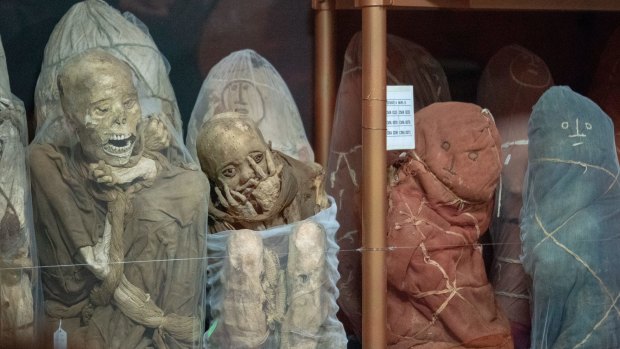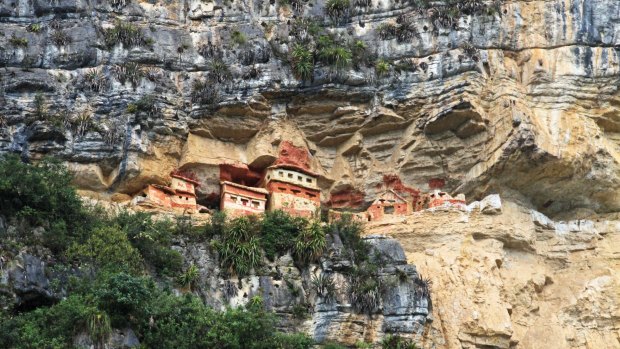This was published 4 years ago
The mausoleums of Revash: Peru's most intriguing attractions most visitors miss
By Rob McFarland

Mummies at Revash.Credit: Matt Corliss
Of the dozens of tightly-bundled figures stacked neatly behind the glass, three are particularly disturbing. They stare straight at me, legs and arms bound snugly to their bodies, hands clutched to their faces as if in agony.
Our guide, Roger, assures us that all the 200-odd people in the room died of natural causes. The reason they look so unnervingly lifelike – albeit in a Munch's The Scream kind of way – is that they're so well-preserved.
Exactly how these mummified human remains have survived for more than 500 years is something of a mystery. They were originally discovered in 1996 in a series of tombs wedged into cliffs 100 metres above Laguna de los Condores, a remote lagoon in northern Peru. Sadly, the farm workers who found them slashed open the funeral bundles and pillaged most of the accompanying artefacts. What was left was then ransacked by souvenir-hunting tourists.

Pre-Inca mausoleum Revash in the mountains of northern Peru. Credit: iStock
Finally, in July 1997, the remaining bodies were salvaged and catalogued, eventually ending up here in a climate-controlled display at the Leymebamba Museum. The complex does a fine job (in Spanish) of chronicling the numerous improbably-located mausoleums dotted around the mountainous Amazonas region of northern Peru. It's believed they were made by the Chachapoya, a civilisation that ruled this area from 800AD until 1470AD, when they were conquered by the Inca. The Chachapoya practised shamanism and there's a wince-inducing display of the braces used to grip people's skulls while they drilled into them to release bad spirits.
Although their contents have all been plundered, many of the mausoleums still exist. One of the most accessible is Revash, located 80 kilometres south of the region's capital, Chachapoyas. After a dizzying, hairpin-filled drive to the small village of San Bartolo, we pay the 10 soles ($A4) admission fee and set off along a meandering 1.5-kilometre-long paved and dirt track.
Along the way, we pass simple wooden houses plastered with grass and clay, where chickens peck outside and children stare shyly from doorways. At one point we have to step aside to make room for two oxen dragging a 10-metre-long log, their sweat-stained handler providing encouragement with a stick.
Eventually, we reach a wooden lookout 30 metres below the tombs, which have been built into a fissure in a limestone cliff. Despite the pilfering and interference by tourists (until recently you could hike up and explore them), the tombs are in remarkably good condition. Resembling a row of miniature houses, the one to two metre-high cream and red structures are made from rock and adobe. Many have cross-shaped windows and some have elegant gabled wooden roofs.
Most experts think they were constructed by the Chachapoya in the 14th century, however Roger suspects there was Inca involvement, given the tombs are rectangular rather than in the cylindrical design normally favoured by the Chachapoya.
Either way, their construction is an impressive feat of ingenuity and engineering. The site was only properly catalogued in the 1940s, when archaeologists found the remains of 11 adults and a baby, along with burial gifts, including musical instruments, stone tools and jewellery.
It says a lot about this less-explored region of Peru that many of its most intriguing attractions were only unearthed during the last 100 years. Not only does it make you wonder what else is out there, it also makes you appreciate being somewhere that's relatively undiscovered (we passed one other group during the hike).
While the mausoleums are undeniably impressive, my abiding memories are of the people we meet in these remote communities: the old man in the village square who rushes home to fetch a piece of Inca pottery he recently found in his backyard; the family that invites us in to look around their simple two-storey house; the delicious hard-boiled eggs and steamed potatoes we enjoy in a local store. With gifts like these, who needs souvenirs?
THE DETAILS
FLY
LATAM flies to Jaen from Melbourne and Sydney via Santiago and Lima. From Jaen to Chachapoyas is a four-hour drive. See latam.com
TOUR
Latin America specialist Chimu Adventures can create a tailor-made Peru itinerary including flights, accommodation, transfers and tours. Phone 1300 720 564; see chimuadventures.com
MORE
Rob McFarland was a guest of Peru Tourism and the Adventure Travel Trade Association (see adventuretravel.biz).
Sign up for the Traveller Deals newsletter
Get exclusive travel deals delivered straight to your inbox. Sign up now.